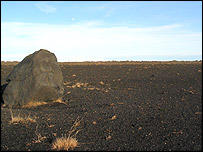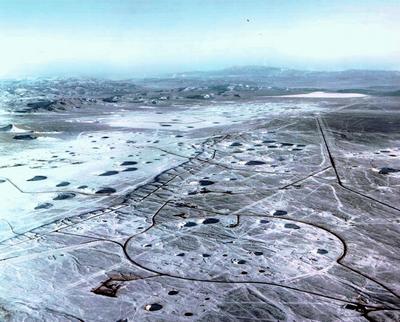Soil-bombing Iceland
The Soil Conservation Service of Iceland is in the midst of a rather heroic effort to de-desertify large parts of the country. Iceland, in fact, is the largest desert in all of Europe. As the BBC says, "The only difference [between the Icelandic desert and] the Sahara is that the sand here is black. Pitch black – with glaciers towering above and the sea shimmering in the distance. And the wind howling in between."

Which sounds like quite a difference.
In any case, the desert's origins are manmade; it is an artificial landscape, bearing traces of the island nation's earlier inhabitants: "Despite the rather frightening name of the country, Iceland was green when Vikings came to settle. About 60% of the country was covered in bushes, trees, grass and all that. (...) But the Vikings, aside from chopping down trees for their own needs, also brought along their sheep. And what do sheep do best? They eat anything that is green."
What interests me here, aside from the ecological message – don't overgraze your territory – is the Soil Conservation Service's preferred method of re-seeding: they pack finely sorted and organized seeds – virtual ecosystems, yet to occur, chosen species by species – into bombs. "Iceland is big and sparsely populated. There are few roads. So, Icelanders decided to 'bomb their own country', dropping the fertiliser and seeds from a WW II DC 3 Dakota."
Earth delivered by warplane.
(You can also listen to this story, as I first did, through an often irritating BBC podcast – how to podcast a landscape, indeed.)
So the bombs collide with the planet, releasing condensed and virtual landscapes: seed-bombs. Soil-bombs. The Icelandic countryside soon becomes an ironic inversion of a warzone: where the bombs fall, trees, grass, and wildflowers grow. Instead of the lunar landscape of the Nevada test site, for instance –

– you get the opposite: strange oases of green, or gardening by artillery.
Which, conveniently, brings me to a new BLDGBLOG project.
It's a landscape proposal: the Artillery Gardens.
Unfortunately, there already is, in London, a place called Artillery Gardens, but no matter. BLDGBLOG's Artillery Gardens will require the following: a very large parcel of land; a Howitzer; several shotguns; a military engineer who can calculate launching arcs and target distances; and some seed-packing volunteers, preferably experienced gardeners. Constant gardeners, perhaps. Everyone would fill up as many shotgun shells and old Howitzer cases as they could, using odd, rare, or otherwise exciting combinations of exotic seed; we'd all don some earplugs; and then it could begin: you'd blast a garden into existence.
Landscape planning as field artillery calculation. Landscape-at-a-distance.
Gardening by artillery.
Through explosion and gunfire and heavy artillery: a rare and fragile garden is born. Species by species, day by day, through blast radii and impact fields, with the "power of endless growth and self-reproduction," these Artillery Gardens will grow.
War as a garden, pursued by other means.

Which sounds like quite a difference.
In any case, the desert's origins are manmade; it is an artificial landscape, bearing traces of the island nation's earlier inhabitants: "Despite the rather frightening name of the country, Iceland was green when Vikings came to settle. About 60% of the country was covered in bushes, trees, grass and all that. (...) But the Vikings, aside from chopping down trees for their own needs, also brought along their sheep. And what do sheep do best? They eat anything that is green."
What interests me here, aside from the ecological message – don't overgraze your territory – is the Soil Conservation Service's preferred method of re-seeding: they pack finely sorted and organized seeds – virtual ecosystems, yet to occur, chosen species by species – into bombs. "Iceland is big and sparsely populated. There are few roads. So, Icelanders decided to 'bomb their own country', dropping the fertiliser and seeds from a WW II DC 3 Dakota."
Earth delivered by warplane.
(You can also listen to this story, as I first did, through an often irritating BBC podcast – how to podcast a landscape, indeed.)
So the bombs collide with the planet, releasing condensed and virtual landscapes: seed-bombs. Soil-bombs. The Icelandic countryside soon becomes an ironic inversion of a warzone: where the bombs fall, trees, grass, and wildflowers grow. Instead of the lunar landscape of the Nevada test site, for instance –

– you get the opposite: strange oases of green, or gardening by artillery.
Which, conveniently, brings me to a new BLDGBLOG project.
It's a landscape proposal: the Artillery Gardens.
Unfortunately, there already is, in London, a place called Artillery Gardens, but no matter. BLDGBLOG's Artillery Gardens will require the following: a very large parcel of land; a Howitzer; several shotguns; a military engineer who can calculate launching arcs and target distances; and some seed-packing volunteers, preferably experienced gardeners. Constant gardeners, perhaps. Everyone would fill up as many shotgun shells and old Howitzer cases as they could, using odd, rare, or otherwise exciting combinations of exotic seed; we'd all don some earplugs; and then it could begin: you'd blast a garden into existence.
Landscape planning as field artillery calculation. Landscape-at-a-distance.
Gardening by artillery.
Through explosion and gunfire and heavy artillery: a rare and fragile garden is born. Species by species, day by day, through blast radii and impact fields, with the "power of endless growth and self-reproduction," these Artillery Gardens will grow.
War as a garden, pursued by other means.





Comments are moderated.
If it's not spam, it will appear here shortly!
could this become an evolution in diplomacy and negotiating war escalation, where instead hotheaded dictators and war-time presidents decide to take turns garden-bombing each other. could become a new grand scale olympic sport, or a new way to encourage young green warlords to channel their bombing tendencies into a better positive outcome? maybe this will be the only time the axis of evil gets to lob a bomb our way without starting WWIII? or maybe superpowers of the future will be able to use these as reseeding tools after they have just used real destructive bombs to take out entire swaths of "enemy territory", this will be "rebuilding-bombing", reBombing, FARM AID Bombs, replete with rich agricultural soil to help would be refugees rebuild and refarm immediately after they've been all but anhiliated. if only we had bombs that could remove water...
See Tree bombs... Where garden wars come to arboreal life...
Post a Comment